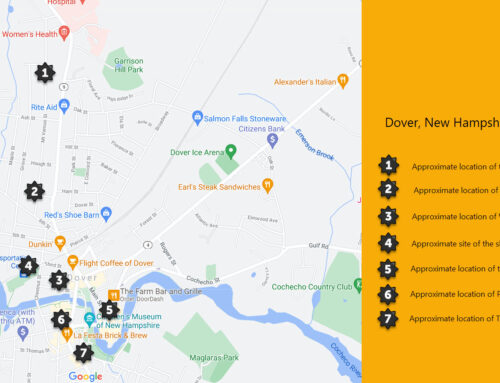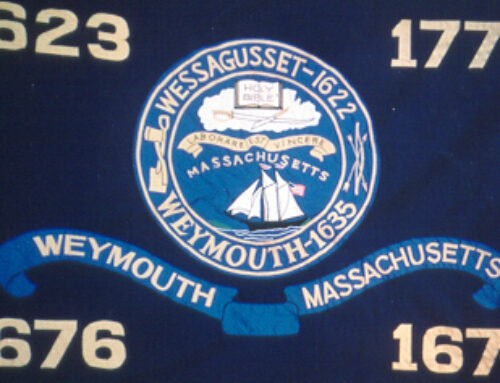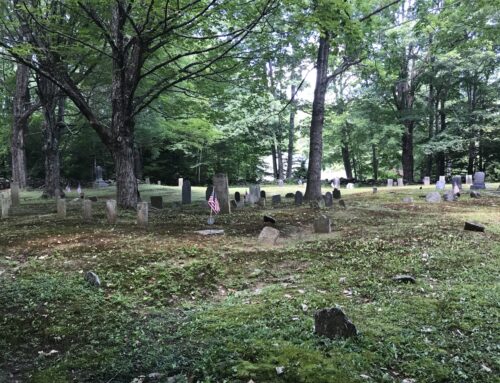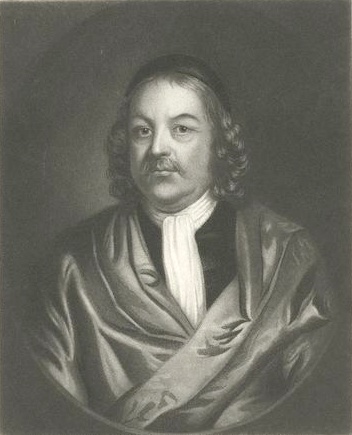

Simon Bradstreet was baptized on 18 March 1603, the second of three sons of Simon and Margaret Bradstreet. His father was the rector of the parish church, an outspoken nonconformist, and his ancestry was of the Irish nobility.
From the ages of 16-18, Simon attended Emmanuel College in Cambridge, but then entered the service of the Earl of Lincoln as an assistant to Thomas Dudley (who later became his father-in-law when Simon married Thomas’ daughter Anne Dudley.) Based on some inconclusive records, it is possible that Simon later returned to Emmanuel College and completed a M.A. degree during the years 1623-1624. Simon’s father had also been educated at Emmanuel College, as were many of the Puritan leaders of that time.
Anne Dudley was born on 20 March 1612 in Northampton, England to Thomas Dudley and Dorothy Yorke. Her father was a steward for the Earl of Lincoln and 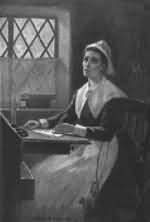 was a descendant of King Henry I and II, King John (Magna Carta), and William the Conqueror among many other royal and noble ancestors. Because of her family’s position, unlike many women of her time, Anne was well educated in the subjects of history, languages, and literature. When she was just seven years old, her father moved the family to the Earl of Lincoln’s estate where he served as the steward of affairs for the Earl. This afforded Anne the opportunity to grow up in a culturally and intellectually stimulating environment where she had access to the Earl’s library. Although as a female she was not allowed to attend school, the same tutor assigned to the Earl’s children was given charge of Anne’s education. Living in the Earl’s household, Anne was also exposed to much debate regarding nonconformist religious ideas and political issues of the day.
was a descendant of King Henry I and II, King John (Magna Carta), and William the Conqueror among many other royal and noble ancestors. Because of her family’s position, unlike many women of her time, Anne was well educated in the subjects of history, languages, and literature. When she was just seven years old, her father moved the family to the Earl of Lincoln’s estate where he served as the steward of affairs for the Earl. This afforded Anne the opportunity to grow up in a culturally and intellectually stimulating environment where she had access to the Earl’s library. Although as a female she was not allowed to attend school, the same tutor assigned to the Earl’s children was given charge of Anne’s education. Living in the Earl’s household, Anne was also exposed to much debate regarding nonconformist religious ideas and political issues of the day.
In 1628, when Anne was just 16 years old and Simon 25, they married. This was a young age for a woman to marry, even at that time. It is possible that their marriage was rushed because of the growing political and religious tensions that also ultimately caused the families to choose to migrate to the New World.

Tattershall Castle in County Lincolnshire where Anne grew up during the years her father worked for the Earl of Lincoln. Simon also worked for the Earl. Photo by By Brian from UK – Tattershall Castle, Tatterhsall, Lincolnshire, CC BY-SA 2.0, Link
That same year, in 1628, Thomas Dudley was among the men who formed Massachusetts Bay Company with the plan to establish a Puritan colony in the New World. Simon began working with the company in 1629 and in April of 1630, he and Anne joined the Dudleys and the colonial Governor John Winthrop on the ship “Arabella” that brought them to Massachusetts Bay. The 350-ton ship was named after the Earl of Lincoln’s sister and it was the flagship for three other ships in the fleet. Based on the journal of John Winthrop, the voyage was slow and stormy with many passengers experiencing seasickness and scurvy. At one point they met a fleet of eight ships that they believed were enemy ships. It was only after a great deal of alarm during which anything that might catch fire was thrown overboard and firearms were readied for battle that they learned it was a friendly fleet.
When they finally arrived, docking in Salem on 12 June 1630, the settlers found a vast wilderness which could not have been more different from what the Dudleys and Bradstreets were used to. In fact, many of the settlers who accompanied the two families died during the next few months from disease, hunger, and general unpreparedness for the challenges they faced in this new world.

This replica of Arbella was built for the 300th anniversary of Salem in 1930. Simon and Anne came on the Arabella to the new Massachusetts Bay Colony along with Anne’s parents and John Winthrop.
Simon and Anne stayed in Boston briefly when they first arrived in the New World, but made their first home in Newtowne (later renamed Cambridge), and this is where their first son Samuel was born. Their home was built near what is now Harvard Square. In 1639 Simon and Anne moved to Salem and then later became founding settlers of Andover in 1648 where they built a large farm and sawmill on a 20-acre property. Simon was a business man and invested in land and shipping interests. In 1660, he purchased shares of a land development company named the Atherton Company, which had interests primarily in the area that is now Rhode Island. He was successful in these ventures as evidenced by the fact that when Simon died he owned 1,500 acres in five communities throughout the colony.
 Anne had suffered with and survived smallpox as a child, which left her in poor health as an adult. As she aged she had difficulty with paralysis taking over her joints. Despite this, Anne and Simon had eight children, with seven surviving to adulthood (one died as an infant). Simon and his father-in-law Thomas Dudley were both instrumental in the founding of Harvard University, and two of Anne and Simon’s sons were graduates of Harvard (Samuel the class of 1653 and Simon the class of 1660).
Anne had suffered with and survived smallpox as a child, which left her in poor health as an adult. As she aged she had difficulty with paralysis taking over her joints. Despite this, Anne and Simon had eight children, with seven surviving to adulthood (one died as an infant). Simon and his father-in-law Thomas Dudley were both instrumental in the founding of Harvard University, and two of Anne and Simon’s sons were graduates of Harvard (Samuel the class of 1653 and Simon the class of 1660).
Anne Bradstreet became famous as one of the early English poets of North America and the first female writer in the colonies to be published. Her poetry was well-known and popular throughout the Old World and the New World. Anne was intellectual and outspoken in her poetry which was unheard of in Puritan days. Her writings were intended primarily for her family and were both intimate and honest about her love for her husband and children, and her understanding of mortality, redemption, and the role of grace. In 1666, the Bradstreet’s home in Andover burned, reportedly due to the “carelessness” of a servant, and the family lost everything in the fire, including Anne’s personal library which was said to have included more than 800 books. Anne also lost family members about the same time, including grandchildren, and some of her poetry expresses her grief over these losses.

Title page, The Tenth Muse Lately Sprung Up in America, printed at London, 1650
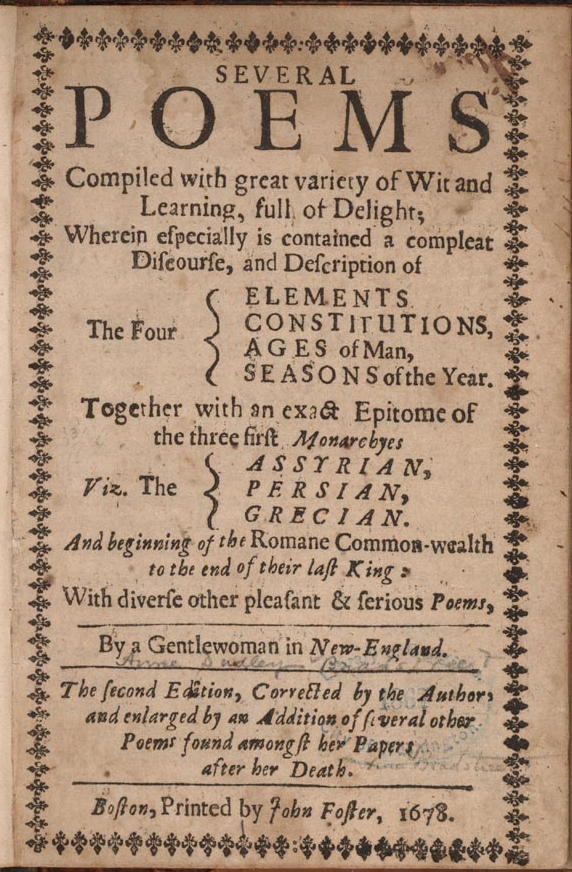
Title page, second (posthumous) edition of Bradstreet’s poems, 1678
It would have been very uncommon and unaccepted for a Puritan woman to try to draw attention to herself. Supposedly without her knowledge Anne’s brother-in-law took a manuscript of her poetry to London. In 1650, Anne’s first volume of poetry titled The Tenth Muse Lately Sprung Up in America, was published by Stephen Bowtell. While Anne received much criticism for engaging in writing, which was not considered an acceptable activity for women at the time, she continued, rebelling against societal norms. In spite of the criticism, her first book was very successful.
Anne died on 16 September 1672 in Andover, Massachusetts at the age of 60. In 2000, in commemoratation of the 350th anniversary of the publishing of her first book, a memorial was placed in the historical burying grounds of North Andover, where Anne is believed to be buried.
In 1678, Anne’s Several Poems Compiled with Great Variety of Wit and Learning was posthumously published in America, and included one of her most famous poems, “To My Dear and Loving Husband” In 1996, Harvard dedicated a gate in her honor as America’s first published poet.
Simon remarried in 1676 to Anne Gardiner. He was a highly respected leader in the Massachusetts Bay Colony and was extensively involved in colonial politics. He was considered a moderate at the time, speaking out in favor of free speech and vehemently opposing the Salem Witch Trials. Just some of the elected and appointed political positions he held, include:
- Governor, Massachusetts Bay Colony, 1689-1692
- Governor, Massachusetts Bay Colony, 1679-1686
- First elected Deputy Governor under John Leverett, 1673-1679
- Colonial Secretary for the Massachusetts Bay Colony, 1630-1644
- Commissioner representing Massachusetts to the New England Confederation, many years
- Diplomat sent to negotiate with settlers, other English colonies, and the Dutch in New Amsterdam
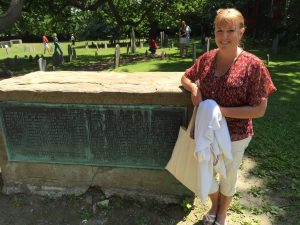
Simon Bradstreet’s tomb
Simon died at his home in Salem on 27 March 1697 at the age of 93. He is buried at the Charter Street Burying Ground in Salem. Notable descendants of Simon and Anne Bradstreet include Herbert Hoover, Sarah Orne Jewett, David Souter, and John Kerry.
Simon was described as seeming to “have been imbued with a spirit more gentle and to have been influenced by a better idea of religious freedom than some of his associates in the colony.” As another historian described him, “He was a man of deep discernment, whom neither wealth nor honor could allure from duty. He poised with an equal balance the authority of the King and the liberty of the people.”
Anne was remembered by a historian as “The most intellectual woman of the colony, poet of ability, worthy daughter of a governor, and worthy wife of another governor. In liberal ideas and toleration she was far ahead of her cold Puritan surroundings.”
Simon and Anne’s children included:
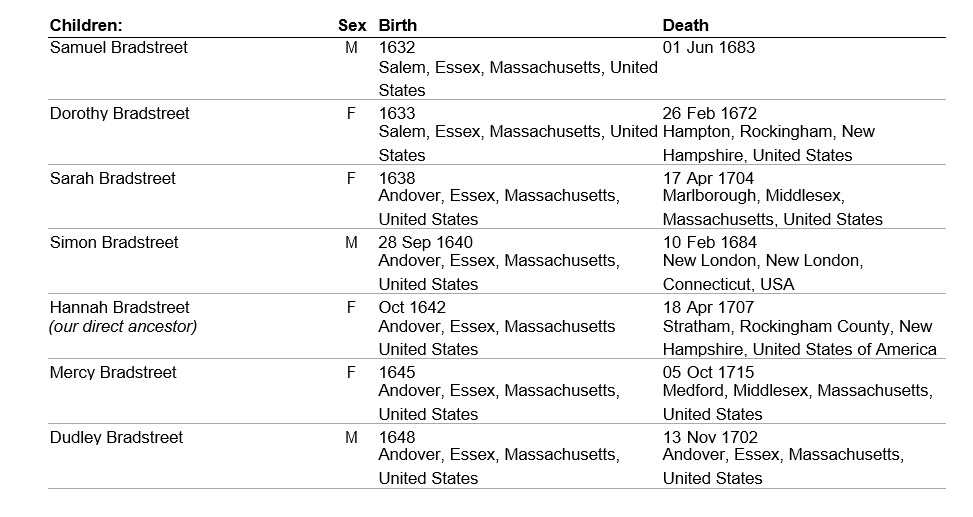
Simon and Anne are the 11th great grandparents of the author through her paternal line
Click to learn more about Simon Brandstreet and Anne Dudley Bradstreet
[crp limit=”6″ heading=”1″ cache=”0″]

